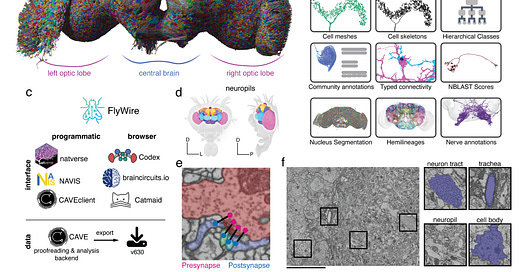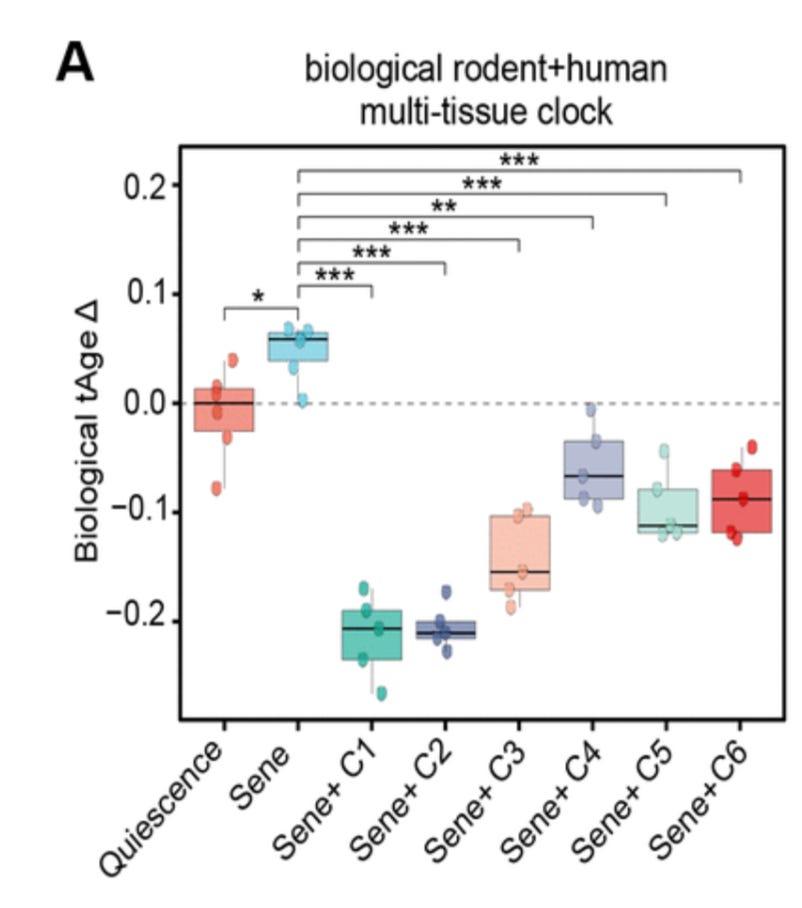1: Last November, the Drosophila larvae connectome was released, covered here at NN. This month, the adult Drosophila connectome dropped. It contains 127,978 neurons and 53 million synapses between them.
They have statistical predictions for the neurotransmitters secreted by each neuron, including GABA, glutamate, acetylcholine, serotonin, dopamine, and the invertebrate neurotransmitter octopamine. They assume each neuron releases only one neurotransmitter type (Dale's Law), even though sometimes co-transmission can occur. Validation suggests the predictions are highly accurate overall, though any individual synapse prediction could be wrong.
They used the connectome to analyze how information flows from sensory inputs to intrinsic and output neurons in the fly brain, via a probabilistic traversal model. Analyzing information flow through connectomes can potentially reveal functional organization.
2: A companion study does cell type annotations of the Drosophila connectome. 4,552 cell types, defined by anatomical location, developmental lineage, 3D morphology, literature knowledge, and a new method of cross-brain connectivity clustering. It contains an interesting comparison between this whole brain connectome to the Drosophila hemibrain previously mapped at Janelia.
3: Yet another companion study, led by Philip Shiu, builds a leaky integrate-and-fire computational model of the Drosophila connectome using Brian 2, using the predicted neurotransmitter identities. It makes various simplifying assumptions like modeling all neurons as spiking, ignoring morphology and receptor dynamics, and assuming a 0 Hz baseline firing rate.
How good was it? They tested 164 model predictions experimentally, mostly related to feeding and grooming circuits. 91% of these predictions were consistent with empirical results. For example, the model correctly predicted neurons that respond to sugar stimulation and neurons required for feeding behavior. Ultimately, it’s hard to say how accurate it is because, as is typical in neuroscience, the authors both made the model and did the evaluation themselves. Ideally, we’d have independent benchmarks. Despite that, it seems reasonably accurate to me.
Since it seems like we’re getting closer to brain emulations, I think it’s high time for some ethical discussions about how the quality of emulated experiences should be assured.
As background, the vertical lobe receives sensory information from approximately 1.8 million input axons. They found that there were two parallel interconnected networks of neurons that input to the vertical lobe — excitatory simple amacrine interneurons (SAMs) and likely inhibitory complex amacrine interneurons (CAMs). SAMs relay sparse sensory inputs, with one-to-one connections from input neurons, while CAMs integrate a broader set of inputs. It seems like the SAMs act like volume knobs on specific sensory inputs, while the CAMs inhibit background noise. This allows stronger representations of specific stimuli to pass on to the output neurons. The end result is a sharper, clearer signaling of salient sensory stimuli.
5: Cell assemblies are groups of neurons in the brain that fire together more frequently than expected by chance. Going back to Hebb in 1949, they are proposed to be the neural basis of memories and cognition. While recent advances allow recording their activity, the underlying synaptic connectivity giving rise to assemblies remains poorly understood. Using an in silico cortical circuit model, a study detects stimulus-evoked assemblies and finds that specific patterns of synaptic wiring shape the membership of cells in assemblies. They also found assembly wiring is efficient, with recurrent motifs and dendritic clustering allowing for the same membership probability with fewer synapses.
6: Does warming the brain up make it perceive time faster? 🥵🤔 A study finds that warming the dorsal striatum in rats sped up neuronal dynamics and biased them to perceive time intervals as longer. Cooling had the opposite effect, slowing striatal dynamics and biasing rats to judge intervals as shorter. The findings suggest that temperature can regulate striatal dynamics to affect time perception and decisions.
7: A study shows that informative biomolecules can survive in the Early Pleistocene fossil record of Africa, using proteomics on dental enamel specimens attributed to the hominin Paranthropus robustus. Ancient proteomics could help us peer back further into the past to answer long-standing questions about how humans evolved.
8: What is the evolutionary purpose of pain? This essay argues that it is to help prioritize actions expected to avoid harm, but that this only makes sense in organisms that are able to make free choices. So only organisms that are able to make free choices — all vertebrates, most insects — should feel pain. Seems like kind of an obvious point but those are usually the best ones. It’s related to the idea that animal welfare should put some priority on animals that experience pain related to the absence of social belonging — “Save the social animals.”
9: In big news from astronomy, a team used radio telescopes to detect evidence of gravitational waves with periods of years to decades from across the universe, likely originating via supermassive black hole pairs billions of light-years away. Related: Do gravitational waves have a form of memory?
10: A study finds that among individuals of African ancestry with the APOE ε3/ε4 genotype, the APOE ε3[R145C] missense variant was associated with an increased Alzheimer's disease risk (odds ratio = 3.01) and earlier age of onset (by 5.87 years) compared to those without R145C. This suggests that R145C may be an ancestry-specific genetic risk factor for Alzheimer's disease in people of African descent.
11: Antipsychotic drugs have long been assumed to treat psychosis primarily by blocking dopamine D2-receptors in striatal neurons. This belief originated from observations that clinical potency correlated with D2 receptor binding affinity. Consequently, therapeutic efforts focused on finding drugs that better target D2 receptor signaling.
However, a new study challenges the central role of D2 receptors in antipsychotic efficacy. The researchers imaged the activity of D1- and D2-receptor-expressing striatal neurons in mice.
Across different antipsychotic drugs, including ones lacking D2 receptor affinity like clozapine, efficacy was associated with normalizing hyperactivity and disorganized dynamics selectively in the D1-expressing neurons. Their results suggest that pathological D1-expressing neuron activity dynamics, not D2-receptor blockade, are key to psychosis and represent a novel therapeutic target. Importantly, the article also questions the widespread receptor–symptom paradigm in psychiatry, which is just a proxy for the underlying neurobiology.
12: Phase II results for the triple–hormone-receptor agonist retatrutide in obesity are startling: with the highest dose, a −24.2% decrease in body weight at 1 year.
13: Seems to be some good news in anti-aging this past month, as there is more progress on partial reprogramming. In vitro evidence shows that small molecules can reverse the transcriptomic age of senescent cells, without erasing cell identity or inducing iPSC-like states. Of course, in vitro is not in vivo.
14: I respectfully disagree with the takes from Joscha Bach that humanity is “destined” to be temporary, that death is only a “tragedy when whatever takes the place of what has died is less valuable”, and that we should just pack it in and not worry about AI x-risk. I’m a critic of some AI safety proposals, like the ones that restrict AI development prematurely in ways that seem likely to make them more dangerous long-term, but most definitely not for these reasons. If it turns out that an AI is going to try to kill all humans at any time that I’m still around, you can count me in for the fight. 🫡😂
15: Related: In a forecasting tournament, domain experts estimated a 20% chance of catastrophe and a 6% chance of human extinction by 2100, while “superforecasters” — people with a good track record of short-term predictions — estimated just 9% and 1% respectively. Forecasters who were better at predicting the views of others (i.e., those who had better “intersubjective accuracy”) estimated lower probabilities of catastrophic and extinction risks.
16: I respectfully disagree with the take from Gideon Lewis-Krause that we should not allow dying patients to try potentially life-saving chemicals because this could make medical studies less well-powered. Of course, if people willingly choose to contribute to medical science by participating in randomized trials, then more power to them.
17: New study uses a two-stage vitrification approach enabling the long-term survival and functional recovery of cryopreserved rat limbs after transplantation. They found that storage at -135°C, slightly below the vitrification solution's glass transition temperature, was necessary to achieve successful transplantation because storing at temperatures lower than this led to tissue fracture and damage.
18: I created lists on the Cryonics Wiki for all organizations performing (a) Preservation and (b) Standby, Stabilization, and Transport (SST). Like the list of long-term care providers, these previously did not exist. Now influencers will have even less of an excuse for making obviously false claims such as “cryonics costs $200,000” without context. Many thanks to Catherine Stewart for assistance.
19: A very nice thesis on the anthropology of cryonics by Sigrid Torsnes at The University of Bergen. One of the main themes is the vibe shift among cryonicists from transhumanism specifically to a more general techno-optimism about biomedical research. Also discusses funding models, professionals vs volunteers, carotid vs aortic cannulation, the sub-culture in Europe vs the United States, chemical fixation as a cheaper method for preservation, and differences in the declaration of legal death across countries.
20: Man Cryogenically Frozen in 2013 Probably Regretting Gangnam Style Pose.
21: "I would stay on with Alcor as a cryonics technician, writer, computer programmer, and mathematical researcher, and I would say, not particularly regret it either. Would I have done better with full-time work in AI? Any choice you make leaves alternatives that might have been better – or not. But we do live still, in spite of any progress we’ve made, in a world of death, which is always there in the background, whatever your occupation. How do you want to cope with that?" - Mike Perry, reflecting on his career path after obtaining a Ph.D. in computer science.














Item 20 IS a joke, right?
Item 18, list of SST providers: This is missing two major providers -- Suspended Animation and I.C.E. For most of their members, CI does not do SST. Members have to make additional arrangements with SA (and, I think, ICE).